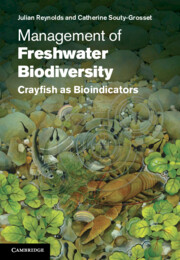Book contents
- Frontmatter
- Contents
- Preface
- Acknowledgements
- Introduction: Biodiversity in freshwater systems, and the key roles played by crayfish
- Part I The present situation of crayfish in world freshwater ecosystems
- 1 Crayfish in the decapod lineage, their natural distribution and their threatened status
- 2 Why are crayfish, among freshwater decapods, considered pivotal in freshwater ecosystems?
- 3 Crayfish as prime players in ecosystems
- 4 Human-mediated threats to crayfish survival
- 5 Crayfish exploitation systems
- Part II Applying science to conservation management
- Part III Knowledge transfer for successful crayfish management
- References
- Glossary
- Index
- Scientific and common English names of well-studied crayfish featured in this book
- Common English and scientific names of well-studied crayfish featured in this book
- Plate section
5 - Crayfish exploitation systems
harvest fisheries, aquaculture and consequences for biodiversity
from Part I - The present situation of crayfish in world freshwater ecosystems
Published online by Cambridge University Press: 05 December 2011
- Frontmatter
- Contents
- Preface
- Acknowledgements
- Introduction: Biodiversity in freshwater systems, and the key roles played by crayfish
- Part I The present situation of crayfish in world freshwater ecosystems
- 1 Crayfish in the decapod lineage, their natural distribution and their threatened status
- 2 Why are crayfish, among freshwater decapods, considered pivotal in freshwater ecosystems?
- 3 Crayfish as prime players in ecosystems
- 4 Human-mediated threats to crayfish survival
- 5 Crayfish exploitation systems
- Part II Applying science to conservation management
- Part III Knowledge transfer for successful crayfish management
- References
- Glossary
- Index
- Scientific and common English names of well-studied crayfish featured in this book
- Common English and scientific names of well-studied crayfish featured in this book
- Plate section
Summary
Introduction
For millennia, large crustaceans have been exploited as food in different parts of the world, tropical and temperate, in intertidal or inshore seas, and in fresh waters. The level of exploitation may lie anywhere along a continuum from casual fishing or poaching, through controlled and regulated exploitation (usually by trapping), to aquaculture, extensive or more or less divorced from the wild environment. Traps set for other species, such as eels and muskrat, may also catch crustaceans as by-catch. Harvesting would lead to holding pens and then basic aquaculture, and finally the emergence of crustacean superspecies that could be cultured across the globe. Genetic evidence suggests that humans in several continents moved around some freshwater species in prehistoric times (e.g. Lynas et al., 2004; Reynolds, 2006). However, the live translocation of aquatic species for cash crop or culture purposes has thrown up its own problems for native faunal biodiversity, most either unforeseen or ignored because of economic opportunism.
Harvest systems were probably at first unregulated, until local recognition of scarcity led to agreements among fishermen to respect closed areas and seasons, particularly in fresh waters. In developing countries, parastacid harvests are lightly regulated, in practice often by traditions or taboos, but with current levels of human population growth and breakdown of traditions, this can lead to severe overfishing. However, regulation of crayfish fisheries was implemented in some developed countries, e.g. for noble crayfish in Europe or signal crayfish in western North America (examples discussed below). Crayfish were established early as a gourmet food among the aristocracy in Nordic countries (Swahn, 2004), and in some cases today, particularly in Europe and Australia, crayfish are exploited to provide for a luxury market rather than for subsistence food. This is often by recreational fishing, where the highly regulated fishing experience may be as enjoyable as the level of catch. In many areas, due to their simple life cycle and nutritional requirements, ease of reproduction in captivity and marketability, crayfish have become very attractive organisms for culture. Major extensive culture has developed to provide commercial-scale harvests. Examples of both harvesting and culture of crayfish are given below.
- Type
- Chapter
- Information
- Management of Freshwater BiodiversityCrayfish as Bioindicators, pp. 111 - 146Publisher: Cambridge University PressPrint publication year: 2011



